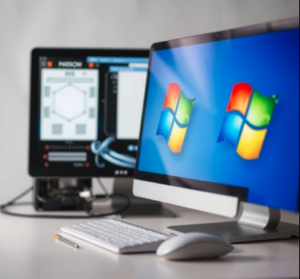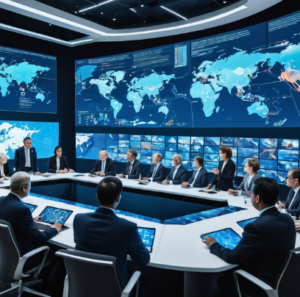
The world of artificial intelligence (AI) has been advancing at a rapid pace, with innovative technologies transforming industries and reshaping the way we interact with digital content. At the forefront of these developments, deepfake technology—a process that uses AI to create hyper-realistic manipulated videos and images—has become both a powerful tool for creativity and a source of concern due to its potential for misuse.
In a surprising move that has stirred both excitement and debate, French President Emmanuel Macron recently shared deepfake videos of himself as part of a campaign to promote the AI Action Summit held in Paris. These videos, which feature Macron in humorous and fantastical scenarios, are not only a bold move to capture public attention but also serve as a conversation starter on the future of AI, its potential benefits, and its dangers.
By leveraging deepfake technology, Macron sought to demonstrate AI’s potential to manipulate and enhance media in ways that were previously unimaginable. However, the deepfakes also raised important ethical questions about AI-generated content and the implications of such technology on privacy, misinformation, and security.
This article takes an in-depth look at Macron’s deepfake videos, their role in promoting the AI Action Summit, and the broader discussions surrounding AI ethics, regulation, and global cooperation in the development of AI technologies.
Macron’s Deepfake Strategy: A Bold Move for AI Awareness
Why Macron Used Deepfakes
President Macron’s decision to incorporate deepfake technology into his promotional campaign was deliberate, creative, and strategic. By sharing AI-generated videos of himself in exaggerated, playful, and surreal scenarios, Macron aimed to spark a conversation around the potential of AI while simultaneously raising awareness about its ethical implications.
The deepfakes, which showed Macron engaging in humorous antics such as dancing to 1980s music and acting as a fictional action hero, were shared across social media platforms and quickly went viral. Macron’s team recognized that traditional forms of promotion might not have the same impact as the eye-catching and engaging nature of deepfake videos. By using such a controversial technology, Macron was able to capture the public’s imagination and create buzz ahead of the AI Action Summit.
The summit, held in Paris and co-chaired by Macron and Indian Prime Minister Narendra Modi, gathered global leaders, AI experts, and industry executives to discuss the future of artificial intelligence and its implications for society. While Macron’s deepfake videos were lighthearted and fun, they carried a deeper message: if AI can be used to create realistic but manipulated media, there must be concerted global efforts to regulate and oversee the technology’s use. The videos served as a stark reminder that while AI offers tremendous opportunities, it also carries inherent risks.
What the Deepfake Videos Show
The deepfake videos released by Macron showcased his participation in some rather unexpected scenarios. One of the most viral videos featured Macron dancing to the French 1980s classic “Voyage, Voyage” by Desireless. In this clip, Macron appeared to move energetically to the beat of the music, creating a visual that was both engaging and humorous. While the video was light-hearted, it also demonstrated how AI could manipulate video content to make it look as though someone is doing something they never actually did.
Another deepfake video featured Macron in the role of MacGyver, the iconic television character known for solving complex problems using everyday objects. The deepfake depicted Macron performing a series of ingenious tasks, highlighting the versatility of AI in transforming video content and creating virtual scenarios that blend reality and imagination. These videos were not just a novelty; they were a demonstration of AI’s ability to alter reality, which is one of the core features that makes deepfake technology so controversial.
These videos were designed not just to entertain but to make a point about AI’s potential. While they were clearly created for promotional purposes, they illustrated that the ability to manipulate images and videos so seamlessly could have far-reaching consequences in various industries and aspects of life. The ease with which one can create believable yet entirely fabricated visual content is a reminder of the growing power of AI and the need for careful oversight in its development.
Public Reactions and Media Attention
The deepfake videos quickly went viral, receiving significant media attention. Public reactions were mixed, with some applauding the creative use of AI and others expressing concern about the implications of such technology. While Macron’s use of deepfakes was intended as a lighthearted way to promote the summit, it also highlighted the double-edged nature of AI. The ability to alter reality for entertainment or political purposes raised questions about the ethical implications of AI-generated content.
Supporters of the campaign argued that deepfakes, when used responsibly, could be a powerful tool for artistic expression and engagement. By using deepfake technology to create fun, viral videos, Macron was able to effectively capture the public’s attention and get people talking about the broader issue of AI regulation. Critics, however, pointed out the dangers of deepfakes being used to manipulate public opinion, spread misinformation, or create false narratives that could damage reputations or undermine trust in digital media.
The discussions surrounding the videos exemplified the growing global concern over AI-generated media. While deepfakes can be entertaining, they also serve as a powerful reminder that AI, if left unchecked, can easily be used for deceptive purposes. The incident sparked important debates about the need for clear ethical guidelines in the development and use of deepfake technology.
AI Action Summit: Key Topics and Participants
The AI Action Summit held in Paris was a major international event aimed at exploring the implications of AI and finding ways to regulate and harness the technology for positive societal outcomes. The summit was co-chaired by Macron and Narendra Modi and featured leading experts and policy makers from around the world. Discussions revolved around how AI could drive economic growth, promote social good, and be regulated effectively to prevent misuse.
One of the main topics at the summit was the potential of AI to drive economic growth and innovation in various industries. Leaders discussed how AI could revolutionize sectors such as healthcare, transportation, energy, and education, providing opportunities for job creation, sustainability, and technological advancement. AI’s ability to solve complex challenges, streamline processes, and enhance productivity was highlighted as a key factor in boosting global economies.
The participants at the summit included prominent figures from the tech industry, such as Sundar Pichai (CEO of Google), Sam Altman (CEO of OpenAI), and Ursula von der Leyen (President of the European Commission). Each of these leaders shared their perspectives on how AI can shape the future and provided insight into how their respective organizations are approaching AI development and regulation.
One of the critical issues discussed was the ethical implications of AI. With AI increasingly integrated into daily life, concerns about privacy, bias, accountability, and ethical decision-making in AI systems are growing. Several summit speakers advocated for the development of a global regulatory framework to ensure AI is deployed in ways that are beneficial and not harmful to society.
Global Cooperation in AI Regulation
During the summit, leaders emphasized the need for international collaboration to create effective regulations for AI. With AI technologies developing rapidly, a lack of global standards could lead to inconsistencies in how AI is used, which could result in ethical violations or misuse of the technology. Macron and other leaders called for collaborative efforts to establish ethical guidelines and regulatory measures that ensure AI development aligns with human rights, privacy, and transparency.
A key focus was how to balance innovation with ethical responsibility. AI offers enormous potential for creating new technologies and driving progress, but it also poses significant risks, especially in terms of data privacy, job displacement, and the creation of manipulated content. The summit stressed the importance of ensuring that AI development prioritizes the public good and addresses the ethical concerns associated with AI technologies.
AI’s Role in Economic Growth and Innovation
One of the central discussions at the summit was how AI can be a driver of economic growth. Countries and businesses around the world are investing heavily in AI research and development, hoping to leverage its potential to revolutionize industries and create new economic opportunities. AI can enhance efficiency, improve decision-making, and automate tasks, all of which could lead to significant advancements in productivity and innovation.
AI’s impact on sectors like healthcare, energy, and transportation is particularly notable. In healthcare, AI can be used to create more personalized treatment options, improve diagnostic accuracy, and even develop new medicines. In the energy sector, AI can optimize energy consumption, help predict energy demand, and increase the efficiency of renewable energy sources. Meanwhile, in the automotive industry, AI is advancing the development of autonomous vehicles, which could revolutionize transportation.
The French government has made AI a priority in its economic strategy, with Macron highlighting the importance of investing in AI to ensure that France remains competitive in the global market. France has set up initiatives to promote AI in research and development, as well as programs to ensure education and training in AI-related fields for the next generation of tech professionals.
A Thought-Provoking Future for AI and Deepfakes
President Macron’s deepfake campaign is a provocative example of how AI technologies can be used to generate attention and stimulate conversation around critical issues. While deepfakes can be humorous and entertaining, they also underscore the power of AI to manipulate reality in ways that could have unintended consequences if left unchecked. As AI technologies continue to evolve, it is crucial for governments, industry leaders, and ethics experts to work together to create a global framework for managing AI development and addressing its potential risks.
The AI Action Summit provided a critical platform for international leaders to engage in discussions about how AI can be regulated and harnessed for the greater good. As AI continues to shape the future of our world, the need for global cooperation in regulating and governing its development will only become more pressing. By focusing on ethics, sustainability, and responsible development, it is possible to ensure that AI technologies are used in ways that benefit humanity as a whole.
Feel free to check out our other website at : https://synergypublish.com



